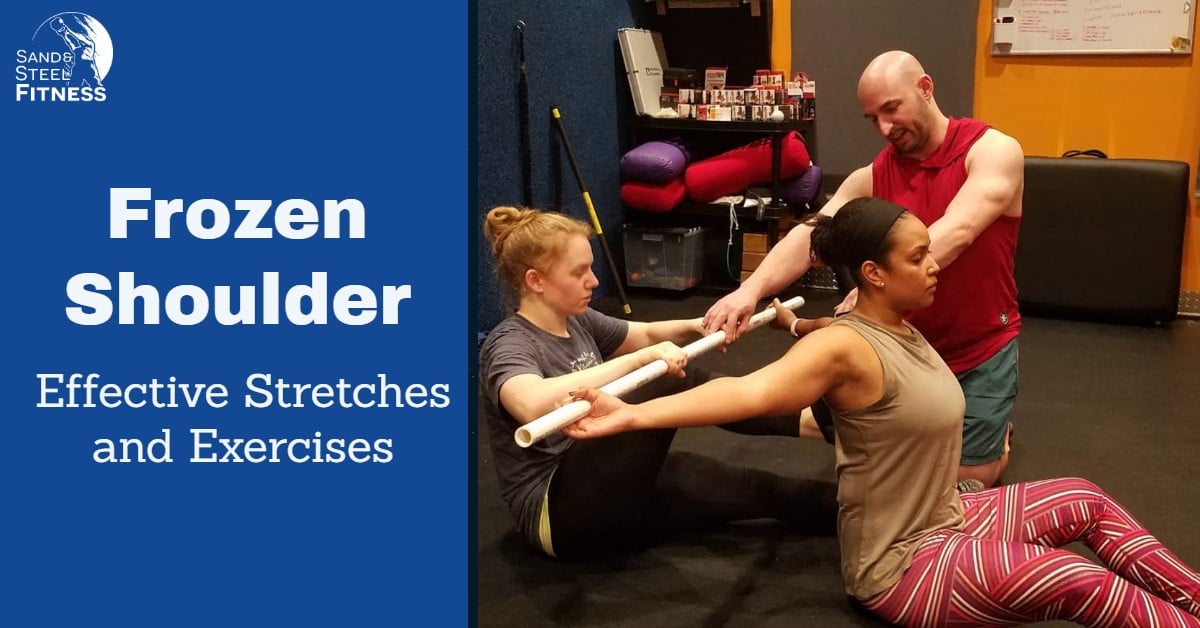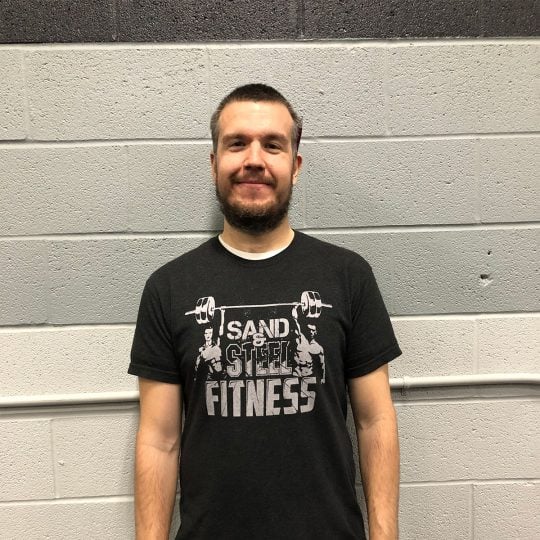Join Coach Max as he reviews the top six videos frozen shoulder exercises and stretches that can be performed at home. Plus get a sneak peak as we take you through our strategy of tracking down shoulder pain to see if frozen shoulder exercises will help. Finally, you can join Coach Paul as he provides you a live video on his favorite ten cable machine exercises for strengthening the shoulder.
The Top 7 Videos for Frozen Shoulder Exercises

Hey Everyone! Coach Max here, and I put together 7 of the best videos I could find that includes exercises for Frozen Shoulder. Frozen Shoulder, Adhesive Capsulitis, can be a painful and frustrating issue. Typically, there are three stages: freezing, stiffness, and thawing. During freezing, range of motion is limited and a person will experience a lot of pain.In the second phase, flexibility in the shoulder will further decrease and pain will generally subside. In the last stage, a person’s shoulder mobility will improve and pain will decrease.
The Harvard Medical School mentions, “the cornerstone of treatment is exercise therapy, concentrating first on exercises that stretch the joint capsule, and later, on strengthening exercises.”
So I put together these 7 amazing videos on Frozen Shoulder Exercises, so you can get a jump start on feeling better. Below the videos, you’ll also find a full case study of our members who has been struggling with an undiagnosed shoulder injury. Coach Max
Paul's 10 Favorite Shoulder Exercises
The key to keeping your shoulders healthy if you are doing yoga, participating in CrossFit, or just playing tennis is having balanced well functioning muscles. These 10 exercises will be helpful to you, and are great to do once a week for shoulder maintenance.
Paul on Shoulder Health Tweet
Paul’s 10 Favorite Cable Machines Exercises to Strengthen the Shoulder.
1️⃣ Half Kneeling High Row
2️⃣ One arm Lateral Pull Down
3️⃣ One Arm Tricep Press
4️⃣ Standing Tricep Extension
5️⃣ Lateral Shoulder Abduction
6️⃣ Standing Low Row
7️⃣ Behind the Back Press
8️⃣ External Rotation with Bent Elbow
9️⃣ Standing Reverse Fly
🔟 Standing Shoulder Flexion into Overhead – 2 Variations.
Physical Therapist's Bob Schrupp Frozen Shoulder Exercises
Physical Therapist’s Bob Schrupp and Brad Heineck cover a 60 second routine that can help people who need frozen shoulder exercises. Bob and Brad review the three stages and provide exercises you can perform at home to improve your shoulder recovery. A person suffering from frozen shoulder will have very limited external and internal rotation. Bob and Brad recommend completing the exercises multiple times throughout the day to improve flexibility and strengthen in the shoulder joint.
Dr. Alan Mandell on Frozen Shoulder Exercises
Dr. Alan Mandell mentions that postural deviations such as forward head and rounded shoulders can bring on the symptoms of frozen shoulder. The video covers 13 stretches a person can perform to help with the symptoms of frozen shoulder and should be performed regularly. The movements include clockwise and counter-clockwise rotations, shoulder shrug with retraction, elbow touches, picture frame, shoulder cross the body stretch, across the body pull, hand wall walker, assisted lowering tricep stretch, table stretch, reverse lift, and chest stretch. All of the stretches demonstrated can be done with little or no equipment.
Ask Dr. Jo about Exercises for Frozen Shoulder
Rebalance on Physical Therapy Exercises for Frozen Shoulder
Rebalance Physical Therapy Center demonstrates 4 exercises that help with relieving stiffness associated from a frozen shoulder. The physical therapist first walks you through what exactly a frozen shoulder is and how having one can impact everyday tasks. The stretches include bridged dowel extensions, dowel assisted external rotation, dowel reverse lifts, and dowel chicken wing stretches. All you need is a dowel, walking-cane, or a broom to help guide your shoulder through each movement.
Dr. Evangelos Mylanos and Dr. Brian Abelson on Scapular Rhythym
Dr. Evangelos Mylonas demonstrates a routine that a person can do using a chair and a can of soup for light resistance. Dr. Brian Abelson covers stretches someone can do with a cane or broom to increase range of motion. They recommend heating the shoulder before attempting any of the exercises. The doctors cover the pendulum exercise, dowel assisted flexion, PNF- shoulder extension exercise, PNF- interal rotation exercise, and PNF – dowel assisted external rotation.

In the fall, I started getting stiffness, soreness, and pain after workouts (mostly bootcamp classes, burpees, pushups, using heavier weights). This was on the left side of my neck, around my collarbone and into my pecs, aching, pulling and twinging sensations. I thought that it was just muscle soreness, or maybe I had tendonitis, and I would use heat or cold and massage to treat, but it gradually got worse and was an issue when I was working as well. I never felt a one time injury, but it could be from so many things (working out, trying to do chin-ups and pull-ups with full body weight, working, carrying heavy groceries upstairs, headstands, etc.) I had some tingling in my left arm for a few days but that went away.
About a month ago I was having a lot of pain and stopped doing any workouts other than yoga and running. I did some more massage and acupuncture/cupping and Advil which helped alleviate my symptoms. I went to the doctor, they said I had a pinched nerve and to get physical therapy. Thinking I may have something else going on, I went back to get an xray which showed I have a very straight neck, and slight misalignments in cervical spine. No pinched nerve from tests they did. They also told me to do PT which I can't get to for another week. I went to a chiropractor to get their opinion, they said my muscles were tight and that I should correct my cervical spine to get the curve back or I may have issues in the future. I did get an adjustment and muscle stim which helped, but since I do not have insurance coverage for chiropractic and I'm not a huge fan of going indefinitely, I'm hoping it's something I can correct on my own. Is this something that you're familiar with and what are your thoughts? I know there are exercises you can do to help get the curve back, and use special pillows or devices, but moving forward, I'm also anxious about getting back to regular workout routine. Thanks for any help with this!Sandra Green
Is Your Injury Frozen Shoulder?
Can we identify the movement pattern that is causing you pain in your neck/shoulder? Probably, we would need to observe your technique on several key exercises. Generally with injuries, the pain comes from the muscle group that is compensating for the weakeness. So the weakened muscle doesn’t hurt, it’s the muscles that are firing and getting overtaxed which hurt. E.g. if your neck is sore, some of the muscles in your shoulder or neck may be doing extra work because some other muscles aren’t doing their job (often these are different muscles in your neck and shoulder).
X-Rays and MRI for Treating Frozen Shoulder
Some of the symptoms you describe and your interpretation of your X-ray are consistent with an impingement of your brachial plexus or median nerves. However you are also suggesting symptoms that are consistent with a deep muscle sprain which has an entirely different treatment protocol.
Xrays and MRIs
An X-ray can show bone misalignment, but an MRI is much better for that (plus it can show soft tissue.) If your bones are misaligned, we need to strengthen the correct muscles so that your move your bones back into the correct position.
Solving Shoulder Pain: A Corrective Exercise Strategy
Step 1: Determine the Source of your Shoulder Pain?
Our process for helping people in your situation is as follows:
- Identify the movement pattern(s) that cause the inflammation by looking at problems with form in functional movement patterns;
- Teaching how to correct those movements patterns,
- Improving your muscle control of the muscle(s) that are not firing, and
- Improving mobility of the joints in that area that causing the mobility restriction.
Advil and Other Pain Relievers
Advil dampens your ability to sense pain. Pain is a warning to your brain, please don’t do this exercise anymore. Anti-inflammatories (Advil is not a strong anti-inflammatory, it is more like a pain blocker) can help, but they won’t prevent you from engaging in the exercise patterns that cause the pain. The pain will just get worse as you do more and more damage to the joint of muscle. One must identify the biomechanical source of the instable movement pattern to prevent it from doing damage to the part of your body that is hurting.
Corrective Exercise Strategy for Shoulder Pain
Once we know where the weaknesses are, we can design a corrective exercise strategy to help you strength the muscles that aren’t functioning properly. We would teach you those corrective exercises and you would be able to do them on your own.
Are the Above Frozen Shoulder Exercises Right for you?
From your email, your pain is more consistent with a shoulder impingement than frozen shoulder. Thus the frozen shoulder exercises we described above might not be applicable. In attempting to diagnose the root cause, I’d start with a shoulder impingement analysis and probably recommend an MRI. Sand & Steel has a shoulder functionality benchmark that we use to test for impingement. It includes several of the better known tests like Hawkins test and the Neer test, plus several tests I designed that give me information about grip, shoulder ROM, and strength.
Exercising with a Shoulder Injury
- For most injuries, Yoga is a good exercise routine. It won’t correct muscle activation problems, but it is good for improving mobility and Range of Motion. If it hasn’t helped your problem in a month or so, it probably won’t with more classes.
- Running is not a good idea with a shoulder impingement (or the symptoms you describe.) The Gait (which is one of the seven classic movement patterns) requires the entire body to move across the sagittal plane in complete symmetry. A shoulder injury is going to necessarily cause a shift in the way your arms move while you are running. It’s very common that there will be a mobility restriction near the area you are having pain. While this may not hurt initially, the mobility restriction will cause an imbalance in the way you run. Another joint (e.g. your hip or maybe your knee) will take on rotational forces that it is designed to leading to another injury down the road.
- Bootcamp classes are notoriously bad for causing shoulder pain. In my youth I did some damage to my shoulder in a bootcamp class as well. 20 students to one instructor doesn’t work. All bootcamp instructors know that they cannot deliver any where near the same level of supervision that they could with one-on-one coaching. They do it to increase their revenue per session. Members like it because it’s cheaper per session, until they get injured.

Frozen Shoulder Exercises
Join Coach Max as he reviews the top six videos frozen shoulder exercises and stretches that can be performed at home. Plus get a sneak peak as we take you through our strategy of tracking down shoulder pain to see if frozen shoulder exercises will help. Finally, you can join Coach Paul as he provides you a live video on his favorite ten cable machine exercises for strengthening the shoulder.

Max Rand – Senior Coach
Personal Training Certifications
- NASM – Corrective Exercise Specialist
- ACE – Certified Personal Trainer



Like back pain, frozen shoulder is one more pain that is bothering these days. Thank you for the helpful post to explain the more beneficial exercises. Thank you for sharing.